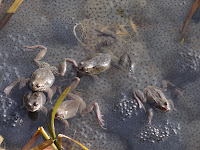 |
| Marsh Fritillary - male |
Finglandrigg Wood sounds like a setting from Lord of the
Rings or one of the Icelandic sagas, but the reality is even more magical. It
is among four sites chosen in Cumbria
to re-introduce the marsh fritillary butterfly after it reached the brink of
extinction in the county around the millenium. I made a round trip of 100 miles
to reach it from our Lakeland
cottage.
“Kaleidoscope” is one of several collective nouns for
butterflies but it suits the marsh fritillary perfectly. Its latin name, Euphydryas aurinia, roughly translates
as “golden floating checkerspot”.
The site, managed by Natural England, has a magic of its own.
In the lay-by where I parked, I bumped into another butterfly enthusiast from
Norfolk (again!), who explained in detail the mile-long trail I needed to
follow to find the butterflies and assured me they were flying in dozens and
much easier to photograph than the elusive mountain ringlets. With my hopeless sense
of direction, I might easily have missed them altogether without his instructions,
despite the helpful butterfly waymarks.
 With rising anticipation, like a child on Christmas Eve, I
walked first through dappled woodland, across a stream humming with damsels and
dragons, through a gate into boggy heathland dotted with grazing cattle. There
was a sign warning of adders and I thought to myself, “Can it get any better?”
but sadly it was already too warm for basking reptiles. Then I came to a
buttercup meadow, a splash of gleaming yellow in the sun, possibly the most
splendid buttercup meadow I’ve ever seen.
With rising anticipation, like a child on Christmas Eve, I
walked first through dappled woodland, across a stream humming with damsels and
dragons, through a gate into boggy heathland dotted with grazing cattle. There
was a sign warning of adders and I thought to myself, “Can it get any better?”
but sadly it was already too warm for basking reptiles. Then I came to a
buttercup meadow, a splash of gleaming yellow in the sun, possibly the most
splendid buttercup meadow I’ve ever seen.
Beyond that another field, damp grassland and suddenly the
kaleidoscope started spinning. The word “fritillary” comes from the latin
“fritillus” – dice box. Romans kept their dice in boxes with an inlaid
chequered pattern, just like the wings of the butterflies named after them.
The Marsh fritillaries flitted from one clump of damp grass
to another, undefeated by a strong gusting breeze in their mission to find a
mate. The foodplant of their larvae is devil’s bit scabious, not yet in flower
when I visited in late May. In summer
the black caterpillars live gregariously on webs spun across it. When I stopped
in nearby Kirkhampton to buy some lunch, the shopkeeper told me that local
children had been planting devil’s bit scabious for the butterflies – “to help
them come back”.
 After a few photographs, I sat down in the damp grass to marvel
at the marsh fritillaries’ checkerboard orange, almost red and creamy yellow
wings, separated by a fat furry body. A mating pair landed on a tussock beside
me – the male larger with broadly open wings, the female fluttering her wings
closed from time to time. The male walked them, oblivious, onto my hand.
After a few photographs, I sat down in the damp grass to marvel
at the marsh fritillaries’ checkerboard orange, almost red and creamy yellow
wings, separated by a fat furry body. A mating pair landed on a tussock beside
me – the male larger with broadly open wings, the female fluttering her wings
closed from time to time. The male walked them, oblivious, onto my hand.
The story of their reintroduction to Cumbria is worth retelling, though
you can find it in more detail on the website of Butterfly Conservation’s
Cumbria Branch. At one time there were some 200 colonies of marsh fritillary
in Cumbria
but by the year 2000 they had dwindled to three and four years later were
facing extinction in the county. The situation continued to worsen despite
attempts to manage their habitats carefully to suit their needs.
Conservationists found just one egg batch on the last site in 2004.
The Cumbria Marsh Fritillary Action Group brought together
decision makers from Butterfly Conservation, Natural England and Defra, and
thanks to a very supportive individual at Natural England gained a licence
within a single day to take the last 150 larvae into captivity. Several reasons
for the drastic decline were considered: loss of habitat as marginal land was
brought into farming production, too much shading from trees on field edges,
parasitic wasps which attack the caterpillars in waxing and waning cycles, and
genetic weakness in the isolated and tiny colony.
 |
| One of the all-important grazers |
Three batches of larvae were raised in captivity, one pure
Cumbrian, one from colonies in Argyll and one a mixture of the two. The results
suggested that genetic weakness was the problem as none of the pure Cumbrian
stock successfully emerged as adults. By 2007 45,000 caterpillars of mixed
Scottish and Cumbrian heritage had been reared and four sites were prepared for
their release. Butterfly conservationists learnt a great deal from the process.
Finglandrigg, 13 km west of Carlisle
on the Solway plain, is the only site open to the public, and what a site it is
– not just for the fritillaries. It also counts red squirrels, brown hares,
badgers, otters, roe deer, many species of dragon and damselflies and warblers
among its residents.
Needless to say, the marsh fritillary is one of the UK’s
fastest declining butterflies, though it is also found in Argyll, the west
coast of Ireland and Wales and the English Westcountry. But the success of the
Cumbrian reintroduction shows just how much a handful of dedicated naturalists
can achieve. I owe them a debt of thanks: they made my heart soar.










































